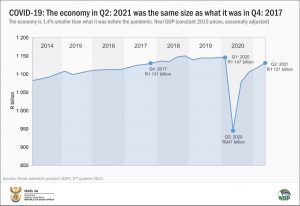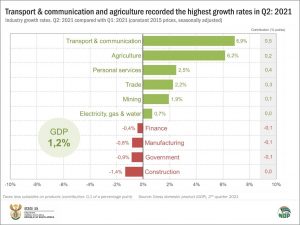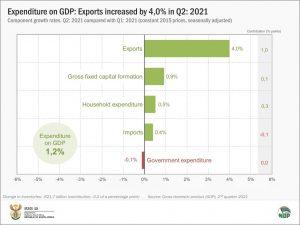The economy grows by 1,2% in Q2: 2021
The South African economy recorded its fourth consecutive quarter of growth, expanding by 1,2% in the second quarter of 2021 (April–June). 1 This followed a revised 1,0% rise in real gross domestic product (GDP) in the first quarter (January–March). Despite the gains made over the last four quarters, the economy is 1,4% smaller than what it was before the COVID-19 pandemic.
The results from this release cover the months of April, May and June. This means that the economic impact of the wave of severe economic disruption, protest action and violence in KwaZulu-Natal and Gauteng, which took place in July, will reflect in the third quarter GDP results that are due for release in December.
COVID-19: We’re not out of the woods yet
The sudden drop in economic activity during the second quarter of 2020, when lockdown restrictions were at their most severe, is evident in the chart below. In the first quarter of that year, real GDP was R1 147 billion, tumbling to R947 billion in the following quarter as the country barricaded itself against the pandemic.
The economy has seen consistent growth since that shock, but not enough to return to pre-COVID-19 levels. Real GDP was R1 131 billion in the second quarter of 2021, 1,4% down from the reading in the first quarter of 2020.
GDP production: COVID-19 related activities spur growth in personal services
Six of the ten industries recorded a rise in production in the second quarter of 2021. The transport & communication, personal services and trade industries were the most significant drivers of growth in the second quarter, with transport & communication and agriculture recording the highest growth rates.
A surge in economic activity related to land transport and communications underpinned the 6,9% rise in transport, storage & communication.
Personal services, which includes health related activities, increased by 2,5% in the second quarter. This was on the back of increased economic activity related to the second phase of the national COVID-19 vaccination programme that kicked off on 17 May. Another contributor to growth in personal services was from medical schemes that recorded a rise in membership numbers.
Trade increased by 2,2%, driven by a rise in economic activity across all trade sectors.
Expenditure on GDP: Exports and household spending support growth
The rise in trade activity in the second quarter is reflected on the demand (expenditure) side of the economy. Household final consumption expenditure increased by 0,5%, driven mostly by a rise in household spending on transport, food & non-alcoholic beverages, and health.
Exports increased by 4,0%, driven mostly by trade in mineral products, pearls, precious & semi-precious stones, precious metals and vehicles & other transport equipment.
For more information, download the Q2: 2021 GDP release and media presentation here.
1 Unless otherwise stated, growth rates are quarter-on-quarter, seasonally adjusted and in real (volume) terms. This is Stats SA’s first GDP release after the completion of its latest benchmarking and rebasing exercise. More information on this exercise is available here. Note that Stats SA no longer uses the annualised rate as the headline growth rate.
Similar articles are available on the Stats SA website and can be accessed here.
For a monthly overview of economic indicators and infographics, catch the latest edition of the Stats Biz newsletter here.




